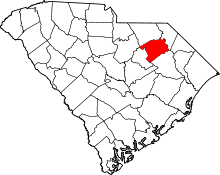Lamar, South Carolina
| Lamar, South Carolina | |
|---|---|
| Town | |
|
Location of Lamar, South Carolina | |
| Coordinates: 34°10′13″N 80°3′45″W / 34.17028°N 80.06250°WCoordinates: 34°10′13″N 80°3′45″W / 34.17028°N 80.06250°W | |
| Country | United States |
| State | South Carolina |
| County | Darlington |
| Area | |
| • Total | 1.2 sq mi (3.0 km2) |
| • Land | 1.2 sq mi (3.0 km2) |
| • Water | 0.0 sq mi (0.0 km2) |
| Elevation | 171 ft (52 m) |
| Population (2000) | |
| • Total | 1,015 |
| • Density | 874.6/sq mi (337.7/km2) |
| Time zone | Eastern (EST) (UTC-5) |
| • Summer (DST) | EDT (UTC-4) |
| ZIP code | 29069 |
| Area code(s) | 843 |
| FIPS code | 45-39805[1] |
| GNIS feature ID | 1246283[2] |
Lamar is a town in Darlington County, South Carolina, United States. The population was 1,015 at the 2000 census. It is part of the Florence Metropolitan Statistical Area. Lamar was named for a family of early settlers.[3]
In February 1970, during a rally opposing busing of pupils for the promotion of school desegregation, militants in Lamar, armed with baseball bats and ax handles, tipped over two buses in defiance of a court order. No one was seriously injured, but police used tear gas to restore order. The incident became an issue in the 1970 gubernatorial election between Republican then U.S. Representative Albert Watson and his successful Democratic opponent, then Lieutenant Governor John C. West. Prior to the violence, Watson had told a "freedom-of-choice" rally in Lamar that the parents should "ignore those who call you racists, bigots, and hard-core rednecks." Watson adopted the slogan "Your Kind of Man"; West had warned that "no reasonable alternative [to desegregation] was feasible." Some believe the incident in Lamar contributed to West's victory in the November general election.[4]
Geography
Lamar is located at 34°10′13″N 80°3′45″W / 34.17028°N 80.06250°W (34.170388, -80.062526).[5]
According to the United States Census Bureau, the town has a total area of 1.2 square miles (3.1 km2), all land.
Demographics
As of the census[1] of 2000, there were 1,015 people, 417 households, and 286 families residing in the town. The population density was 874.6 people per square mile (337.8/km²). There were 467 housing units at an average density of 402.4 per square mile (155.4/km²). The racial makeup of the town was 53.50% White, 45.71% African American, 0.10% Native American, 0.10% Asian, and 0.59% from two or more races. Hispanic or Latino of any race were 0.89% of the population.
There were 417 households out of which 24.2% had children under the age of 18 living with them, 46.0% were married couples living together, 18.2% had a female householder with no husband present, and 31.2% were non-families. 29.3% of all households were made up of individuals and 15.3% had someone living alone who was 65 years of age or older. The average household size was 2.43 and the average family size was 3.01.
In the town the population was spread out with 24.5% under the age of 18, 6.9% from 18 to 24, 25.7% from 25 to 44, 25.8% from 45 to 64, and 17.0% who were 65 years of age or older. The median age was 41 years. For every 100 females there were 91.1 males. For every 100 females age 18 and over, there were 81.9 males.
The median income for a household in the town was $28,571, and the median income for a family was $35,789. Males had a median income of $29,000 versus $26,250 for females. The per capita income for the town was $15,473. About 22.4% of families and 24.4% of the population were below the poverty line, including 35.7% of those under age 18 and 17.7% of those age 65 or over.
Notable people
- David Beasley, 113th Governor of South Carolina from 1995 until 1999[6]
- Levon Kirkland, former NFL linebacker
- John Abraham (American football), professional football player for the NFL's Arizona Cardinals
- Michael Hamlin, former NFL safety
- Marshall McFadden, professional football player for the NFL's St. Louis Rams
References
- ↑ 1.0 1.1 "American FactFinder". United States Census Bureau. Retrieved 2008-01-31.
- ↑ "US Board on Geographic Names". United States Geological Survey. 2007-10-25. Retrieved 2008-01-31.
- ↑ Gannett, Henry (1905). The Origin of Certain Place Names in the United States. Government Printing Office. p. 180.
- ↑ Billy Hathorn, "The Changing Politics of Race: Congressman Albert William Watson and the South Carolina Republican Party, 1965-1970", South Carolina Historical Magazine Vol. 89 (October 1988), p. 232-233
- ↑ "US Gazetteer files: 2010, 2000, and 1990". United States Census Bureau. 2011-02-12. Retrieved 2011-04-23.
- ↑ "South Carolina Governor David M. Beasley". National Governors Association. Retrieved December 21, 2012.
External links
| Wikimedia Commons has media related to Lamar, South Carolina. |
| |||||||||||||||||||||||||||||
